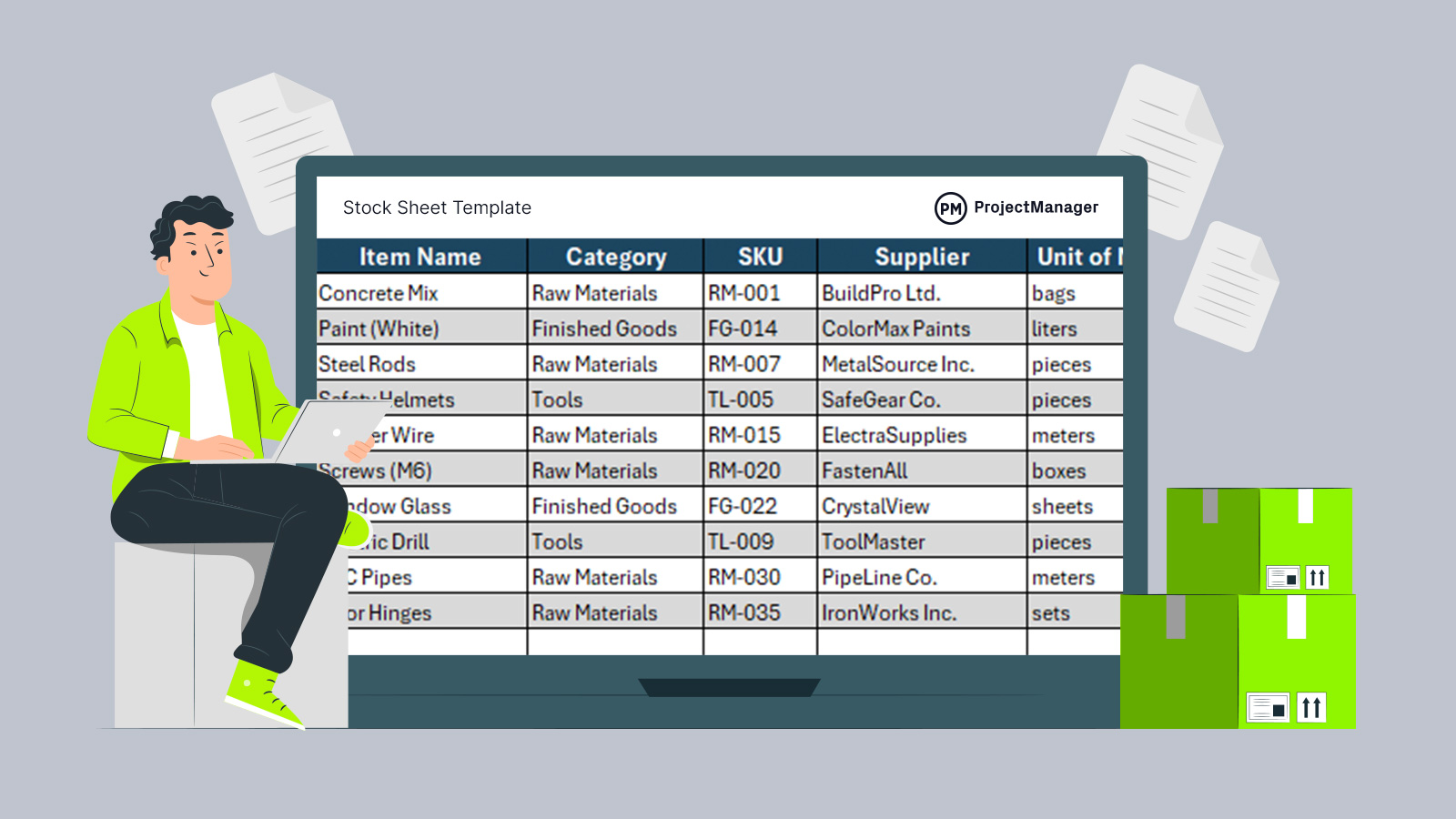A stock sheet template is an essential tool for businesses to track inventory efficiently, monitor stock levels and ensure accurate reporting. By using a stock sheet template, organizations can maintain proper inventory records, reduce stockouts and streamline restocking processes, saving time and minimizing errors. This template simplifies the tracking of items, quantities and locations, making inventory management more organized and transparent.
Project management software enhances stock tracking by automating updates, providing real-time inventory visibility and integrating stock data with broader business workflows. Users can manage multiple warehouses, generate instant reports and track trends to make informed purchasing decisions. Software also allows teams to collaborate on stock management without delays, reducing human error and ensuring data consistency across departments.
ProjectManager is ideal for managing stock sheets because it combines powerful inventory tracking with project management features. Teams can create stock sheets with the sheet view, set alerts for low inventory,and link stock usage to tasks or projects. AI-powered dashboards, reports and real-time updates provide full visibility into stock levels, making it easier to plan procurement and maintain optimal inventory for smooth operations. Get started with ProjectManager today for free.
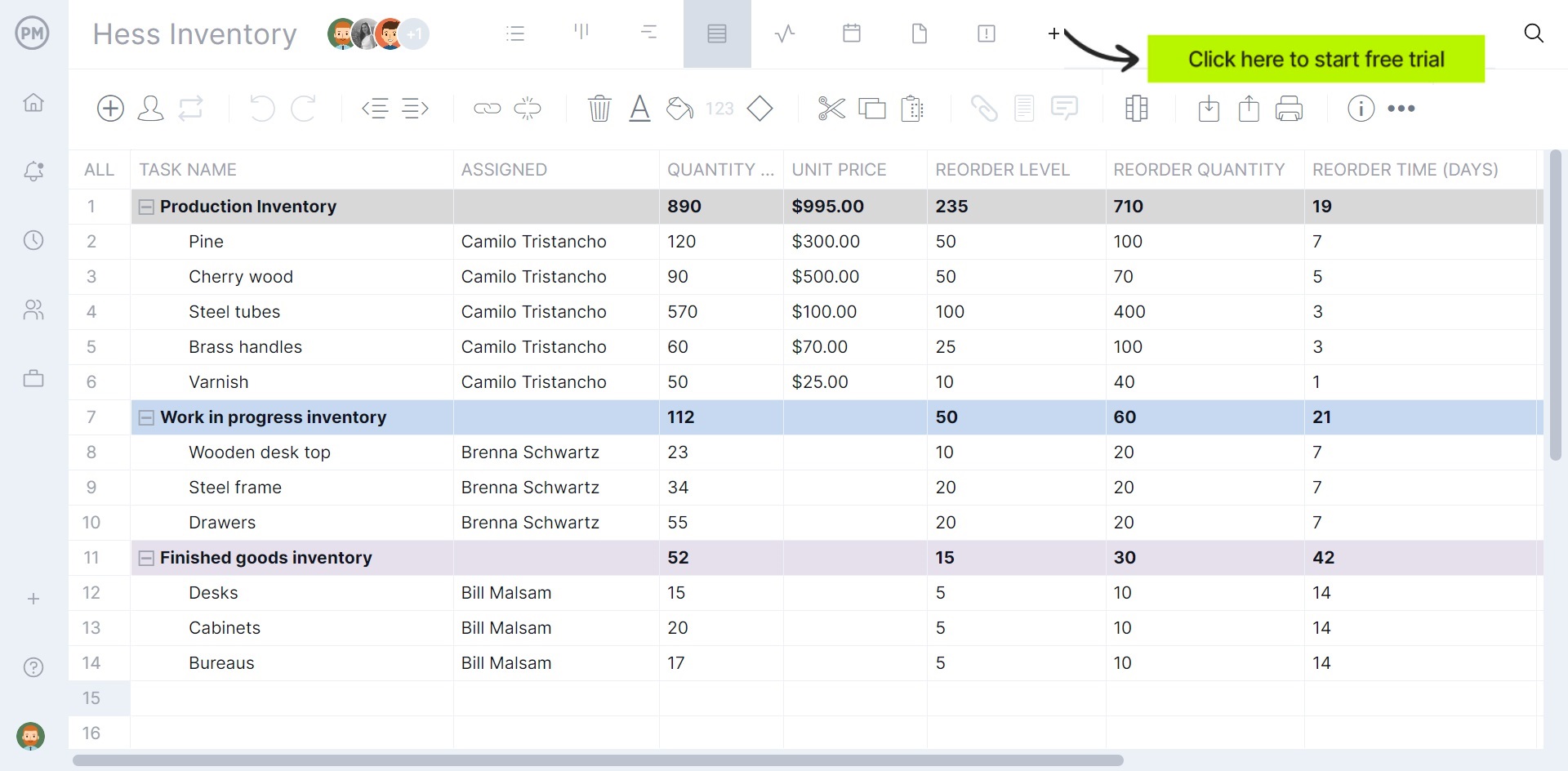
Why You Need a Stock Sheet Template
A stock sheet template is essential for maintaining accurate inventory records, preventing stockouts and reducing excess inventory. It helps businesses organize item details, quantities, locations and reorder points in a structured format. Teams can use a template to streamline stock tracking, simplify audits and quickly identify discrepancies, saving time and improving operational efficiency. Accurate stock data also supports better purchasing decisions and ensures smooth day-to-day operations without interruptions or delays.

When to Use a Stock Sheet Template
A stock sheet template should be used whenever inventory needs to be tracked accurately, whether for daily operations, monthly audits or seasonal stock management. It is particularly useful during stocktaking, when introducing new products or when preparing for busy periods that require careful monitoring of inventory levels. Using a template ensures that stock movements are recorded consistently, reducing errors and providing clear insights into stock availability and turnover.
Who Should Use This Free Stock Sheet Template?
This free stock sheet template is ideal for warehouse managers, inventory clerks, procurement officers, retail store managers and small business owners. Anyone responsible for maintaining stock records, tracking quantities and reporting inventory can benefit from this template. It’s especially useful for teams without advanced inventory software, providing an easy, organized way to record stock data, maintain transparency and ensure accurate reporting across all levels of the organization.
How to Use this Stock Sheet Template for Excel
Using a stock sheet template in Excel simplifies inventory management and ensures consistency across your records. Start by entering detailed information for each stock item, including identification, supplier and storage details. This process helps maintain accurate tracking, facilitates audits and allows quick insights into inventory levels. Excel’s sorting, filtering and calculation features enhance usability, making it easier to manage large volumes of stock efficiently while reducing errors and improving operational control.
1. Enter Information about Stock Items
Begin by inputting relevant information for each stock item in the template. Ensure all fields are completed accurately to maintain proper inventory tracking, avoid stock discrepancies and optimize reorder planning. This foundational step ensures that your stock data is organized and reliable for reporting and decision-making purposes.
- Item Name: The specific name or title of the stock item, used to identify and distinguish it from other inventory in the stock sheet template.
- Category: The classification of stock items into groups, such as electronics, office supplies or raw materials, for easier organization and reporting.
- Stock Keeping Unit (SKU): A unique alphanumeric code assigned to each item to track inventory, simplify ordering and maintain accurate records in the stock sheet template.
- Supplier: The name of the vendor or provider from whom the stock item is purchased, enabling easy reference for reorders and supplier management.
- Location: The physical storage place of the stock item, such as a warehouse, shelf or bin, ensuring quick access and proper inventory control.
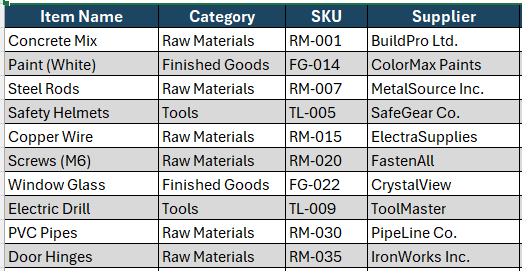
2. Establish Units of Measurement and Unit Cost
Once stock items are entered, define the unit of measurement for each item, such as pieces, kilograms, liters or boxes, to standardize reporting and calculations. Next, assign a unit cost reflecting the purchase price per single unit. This allows accurate calculation of total stock value, supports budgeting and improves cost tracking. Consistent units and costs also simplify audits, financial reporting and decision-making, ensuring inventory data in the stock sheet template is precise, actionable and ready for analysis across departments.

3. Log Transactions
After defining items and unit costs, record all inventory movements in the stock sheet template. Track opening stock, additions and withdrawals to maintain accurate quantities. Logging transactions ensures that the stock sheet reflects real-time inventory levels, supports financial reporting and helps prevent shortages or overstocking. Consistently updating the sheet improves accountability, enables trend analysis and allows managers to make informed decisions regarding purchasing, production and sales. Accurate transaction logs strengthen inventory control and audit readiness.
- Opening Stock: The quantity of each stock item available at the start of the accounting period, serving as the starting point for inventory tracking.
- Stock In: All new inventory received during the period, including purchases, returns or transfers from other locations, increasing stock levels.
- Stock Out: Any stock removed during the period due to sales, consumption or transfers, reducing the available inventory in the stock sheet.
- Closing Stock: The quantity of each item remaining at the end of the period, calculated by adjusting opening stock for stock in and stock out.
- Total Value: The monetary worth of closing stock, calculated by multiplying the closing quantity by the unit cost for accurate financial reporting.
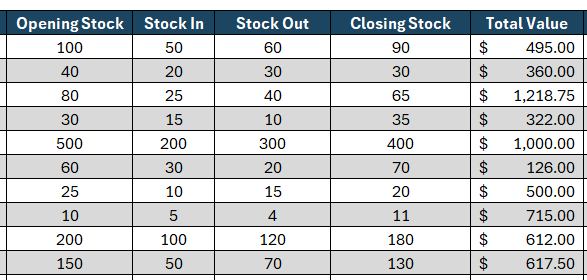
4. Define a Reorder Level
Setting a reorder level in your stock sheet template ensures inventory never falls below a critical point. This threshold signals when new stock should be ordered, helping prevent shortages and production delays. Consider average usage rates, lead times from suppliers and seasonal demand when defining reorder levels. By monitoring stock against this level, managers can proactively plan purchases, maintain smooth operations and avoid excess inventory. A clearly defined reorder level supports efficient supply chain management and improves overall inventory control.
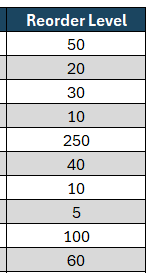
What Other Templates Can Help with Manufacturing Projects?
Using a stock sheet template is just one part of effective manufacturing project management. Other templates can help streamline processes, improve organization and enhance visibility across operations. These templates provide structured ways to map processes, track equipment and schedule maintenance. Below are a few key templates that complement a stock sheet template and make manufacturing project management more efficient and accurate.
SIPOC Template
Download this free SIPOC template to map out Suppliers, Inputs, Process, Outputs and Customers, providing a high-level overview of a manufacturing process. It helps teams understand process flow, identify key stakeholders and clarify inputs and outputs to improve efficiency and reduce errors.
Equipment Inventory Template
Use this free template to track all equipment used in manufacturing projects, including details like serial numbers, purchase dates and maintenance schedules. It ensures accurate recordkeeping, reduces downtime and helps plan replacements or upgrades efficiently.
Maintenance Schedule Template
This free maintenance schedule template organizes routine and preventive maintenance tasks for machinery and equipment. It helps teams plan service dates, track completed maintenance and reduce unexpected breakdowns, improving overall productivity and safety.
How to Manage Manufacturing Projects With ProjectManager
ProjectManager is a comprehensive software solution that helps manufacturing teams plan, execute and monitor projects efficiently. Its multiple project views, including Gantt charts, kanban boards, and task lists, give managers a clear overview of all ongoing tasks and deadlines. Real-time dashboards allow teams to see progress instantly, identify bottlenecks and ensure that production schedules stay on track, reducing delays and improving overall operational efficiency.
Optimize Resource Management
With ProjectManager, manufacturing teams can assign resources effectively, track availability and balance workloads to prevent overutilization. Its resource planning features allow managers to allocate staff, machinery and materials where they are needed most. Automated alerts notify managers when resources are overbooked or underutilized, helping optimize productivity while maintaining cost efficiency. This level of insight ensures projects stay within budget and deadlines are met consistently.
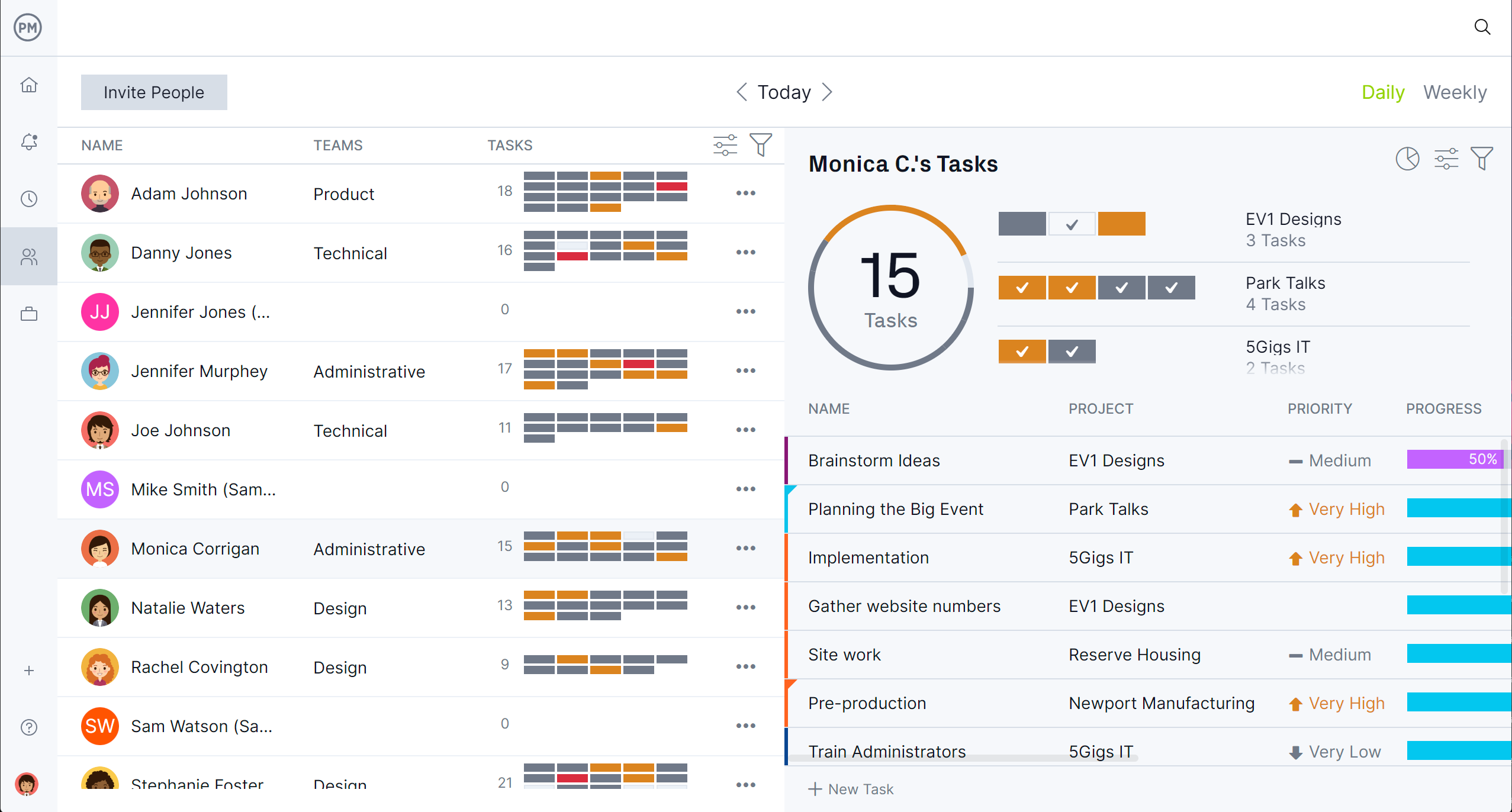
Track Progress and Performance
ProjectManager enables continuous tracking of project performance through timesheets, workload charts and real-time reporting. Teams can monitor labor hours, material usage and task completion rates, generating actionable insights. AI Project Inisights predicts potential delays and provides recommendations to mitigate risks. By consolidating all project data in one platform, managers gain full visibility into operations, streamline decision-making and maintain accountability across all departments.

Related Inventory Management Content
A stock sheet template is only one part of the larger inventory management process. To continue learning about this subject, follow the links below. They lead to articles on equipment inventory, cycle counting and much more.
- 18 Free Manufacturing Excel Templates (Download Now)
- 7 Free Inventory Templates: Spreadsheets, Lists & More
- Equipment Inventory: A Quick Guide
- Cycle Counting Explained: Process, Methods, Pros and Cons
ProjectManager is online project and portfolio management software that connects teams, whether they’re in the office or out in the field. They can share files, comment at the task level and stay updated with email and in-app notifications. Get started with ProjectManager today for free.
